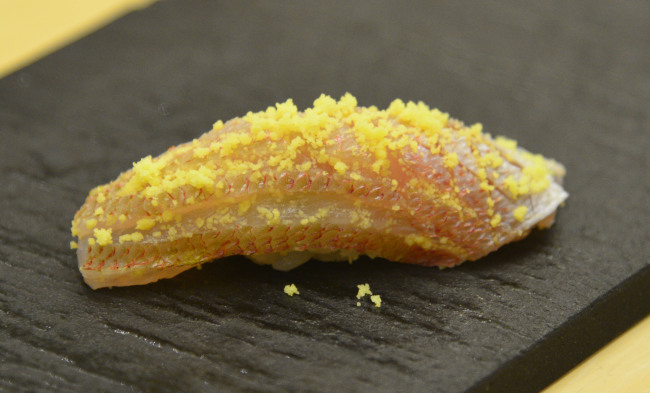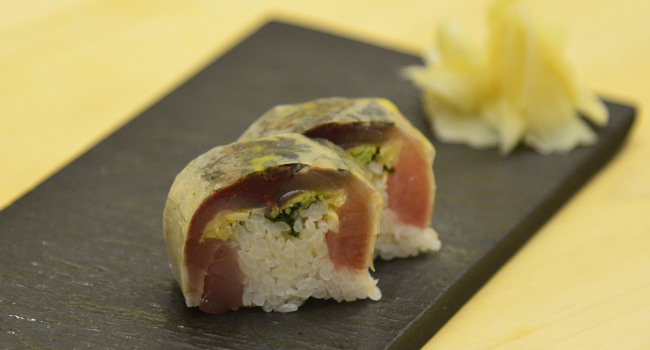Sushi to be savored one piece at a time
Generous, friendly dining at Sushi Koji’s counter
By Korea HeraldPublished : March 27, 2015 - 19:09
When that glistening morsel of sushi, a thin slice of ruby-fleshed tuna resting over snow white rice, is served by Koji Nakamura, head chef of Sushi Koji, it is melt-in-your-mouth good.
The “akami” tuna is gleaned from near the spine of the fish and is not as expensive as “toro.” It is particularly memorable because Nakamura has taken that more common cut of tuna, one that has probably been enjoyed at countless sushi restaurants time and time again, aged it and then allowed it to briefly marinate in soy sauce in a manner that allows the naturally sweet flavors of the fish to shine through.

Then there is the rice, far from bland, with the flavors of vinegar prominent in Sushi Koji’s rice, as is the texture of each grain.
“I feel that people think that sushi is primarily about the fish,” said Nakamura, 37. “But I feel that over 70 percent of the taste of sushi is determined by the rice.”
“The rice must taste good for the sushi to taste good,” said the sushi veteran, who spent eight years learning the craft in Japan before striking out on his own.
For Nakamura, good sushi rice is not simply about the texture and flavor of the rice itself but also its temperature.
With white-fleshed fish and tuna, he uses warm rice. With clams he uses rice that is slightly less warm and even cooler rice with blue-skinned fish.
When warm rice is used, Nakamura explains, it delivers impact.
Impact is the right word to use to describe the sushi at Nakamura’s namesake restaurant. Like the buttery, rich uni served up in a hedonistic dollop over sugary amaebi, raw sweet shrimp, and swaddled in impossibly thin yet crispy and delicate dried laver.
The “akami” tuna is gleaned from near the spine of the fish and is not as expensive as “toro.” It is particularly memorable because Nakamura has taken that more common cut of tuna, one that has probably been enjoyed at countless sushi restaurants time and time again, aged it and then allowed it to briefly marinate in soy sauce in a manner that allows the naturally sweet flavors of the fish to shine through.

Then there is the rice, far from bland, with the flavors of vinegar prominent in Sushi Koji’s rice, as is the texture of each grain.
“I feel that people think that sushi is primarily about the fish,” said Nakamura, 37. “But I feel that over 70 percent of the taste of sushi is determined by the rice.”
“The rice must taste good for the sushi to taste good,” said the sushi veteran, who spent eight years learning the craft in Japan before striking out on his own.
For Nakamura, good sushi rice is not simply about the texture and flavor of the rice itself but also its temperature.
With white-fleshed fish and tuna, he uses warm rice. With clams he uses rice that is slightly less warm and even cooler rice with blue-skinned fish.
When warm rice is used, Nakamura explains, it delivers impact.
Impact is the right word to use to describe the sushi at Nakamura’s namesake restaurant. Like the buttery, rich uni served up in a hedonistic dollop over sugary amaebi, raw sweet shrimp, and swaddled in impossibly thin yet crispy and delicate dried laver.

The taste of anago, saltwater eel, is elevated by a smattering of grated yuzu over it, while that final piece of tamago, omelet, is sweet, rich and custardy, a texture that is achieved through the use of mountain yam.
To heighten the experience, Nakamura recommends eating each piece with your hands. This enables the sushi chef to craft each piece with what is considered to be the right amount of firmness ― one that allows for a certain amount of air within each piece.
Some sushi, Nakamura explained, will be made a little bit firmer for those using chopsticks, so it does not fall apart when it is picked up.
“I suppose you could say we are able to make a more perfect sushi,” Nakamura explained on why eating with your hands is suggested.
Good sushi is not the only memorable aspect of dining at Sushi Koji.
The not-too-formal hospitality and the way each chef offers up additional morsels of sushi to ensure that diners leave satisfied with their meal all play a key role in the Sushi Koji experience.
“First, our food needs to taste good,” Nakamura explained. “Second, the experience of eating here needs to be fun.”
The at-ease atmosphere at Sushi Koji seems to stem from its co-owner and head chef’s own preference for interaction between the chef and diners.

Nakamura first knew he wanted to specialize in sushi many years ago when he was working part-time at a casual sushi restaurant. One of the defining charms was the atmosphere of the restaurant.
“I think I really liked the ambiance of the restaurant, the way there was a lot of interaction between the chef and the customers and how they were always chatting with each other,” Nakamura said.
It was then that he knew he wanted to become a sushi chef.
To master sushi, he clocked eight years in Japan. Then he racked up experience at a seafood restaurant in Australia and returned to Japan to learn kaiseki-ryori at a famed Michelin-starred establishment before coming to Korea, where he worked at two restaurants before helping launch Sushi Koji in Seoul’s Cheongdam-dong last May.
At Sushi Koji, in what seems to be a reflection of Nakamura’s desire to maintain a line of communication between the chef and customer, there is an air of polite yet slightly casual conviviality ― chefs interact with diners, explaining each piece of sushi as it is served.
“I think we are forging good relationships with our customers through our sushi,” said Nakamura.
By Jean Oh (oh_jean@heraldcorp.com)
-
Articles by Korea Herald








![[Kim Seong-kon] Democracy and the future of South Korea](http://res.heraldm.com/phpwas/restmb_idxmake.php?idx=644&simg=/content/image/2024/04/16/20240416050802_0.jpg&u=)








![[KH Explains] Hyundai's full hybrid edge to pay off amid slow transition to pure EVs](http://res.heraldm.com/phpwas/restmb_idxmake.php?idx=652&simg=/content/image/2024/04/18/20240418050645_0.jpg&u=20240418181020)

![[Today’s K-pop] Zico drops snippet of collaboration with Jennie](http://res.heraldm.com/phpwas/restmb_idxmake.php?idx=642&simg=/content/image/2024/04/18/20240418050702_0.jpg&u=)